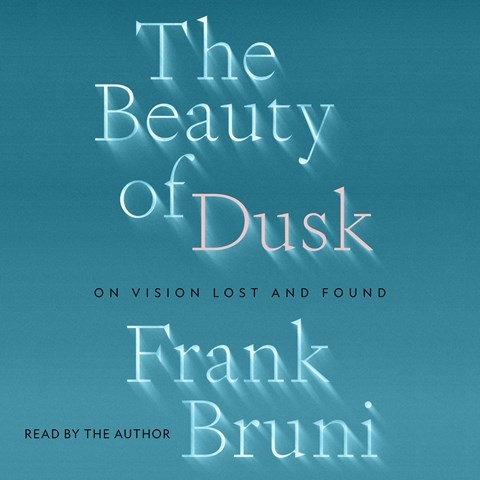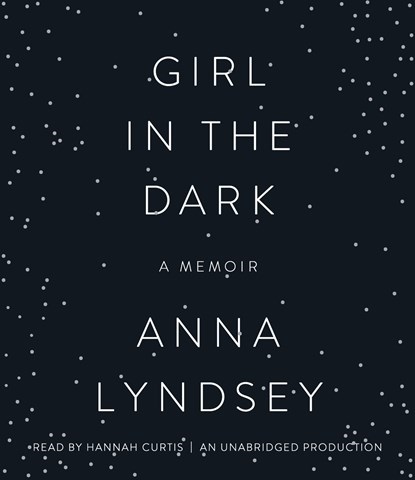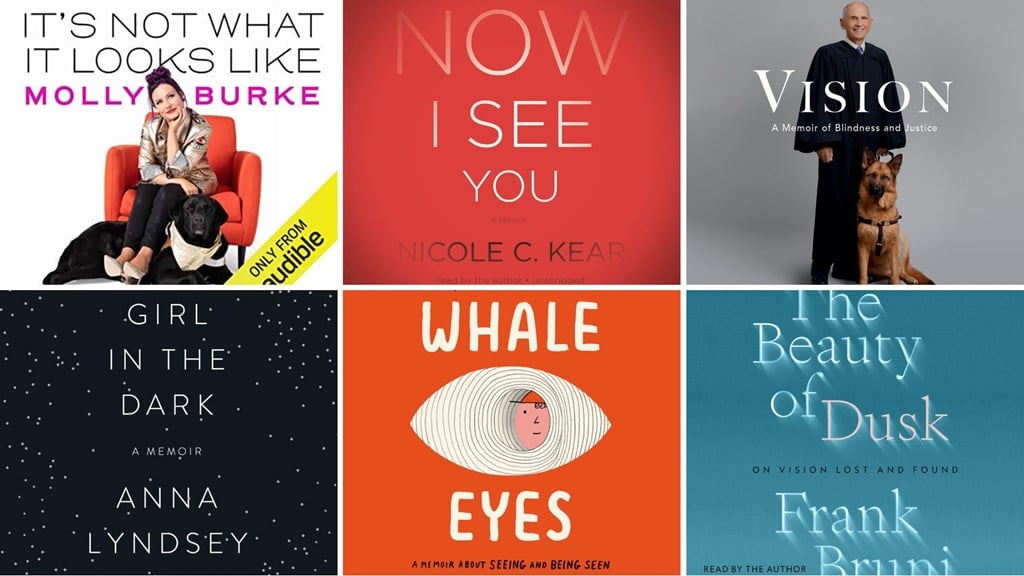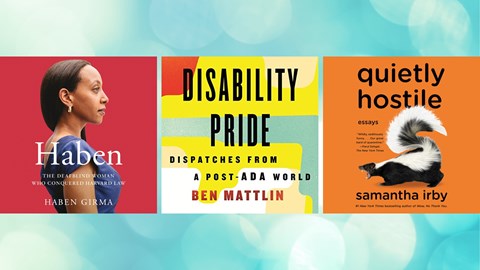Listen to this article, read by narrator Emily Pike Stewart
Have you ever wondered what it is like to lose all or a part of your vision? How can you manage your fear of losing your independence, and what adaptations will you need to make? When I was diagnosed with a degenerative retinal disease at age 47, a blind friend told me that I can still do everything that I previously did but that I may need to do it in a different way or with assistance. And audiobooks, of course, are a vital way for people with impaired vision to keep literature in their lives. The following six audiobook memoirs confirm that blind and visually impaired persons can lead full and productive lives.
 When a person is blind or has vision loss, they need to "see" in a different way. As New York Times columnist Frank Bruni explains in his affecting memoir, THE BEAUTY OF DUSK: On Vision Lost and Found: "Interesting, isn't it, how limber and omnipresent the verb ‘see’ and its variants are, how easily and constantly those variants toggle from referring to the visual processing of objects to the mental processing of reality?" Narrating his own work in a calm, straightforward manner, Bruni imparts how he lost his vision in one eye after a stroke. He takes listeners on the journey he undertook to determine what adjustments he needed to make and what was truly important to him. After interviewing blind and visually impaired individuals, as well as those with other disabilities or advanced age, Bruni draws upon those who see their vision loss as an adventure, rather than a misfortune.
When a person is blind or has vision loss, they need to "see" in a different way. As New York Times columnist Frank Bruni explains in his affecting memoir, THE BEAUTY OF DUSK: On Vision Lost and Found: "Interesting, isn't it, how limber and omnipresent the verb ‘see’ and its variants are, how easily and constantly those variants toggle from referring to the visual processing of objects to the mental processing of reality?" Narrating his own work in a calm, straightforward manner, Bruni imparts how he lost his vision in one eye after a stroke. He takes listeners on the journey he undertook to determine what adjustments he needed to make and what was truly important to him. After interviewing blind and visually impaired individuals, as well as those with other disabilities or advanced age, Bruni draws upon those who see their vision loss as an adventure, rather than a misfortune.
 One of the individuals Bruni interviewed is retired U.S. Court of Appeals Judge David S. Tatel. In his powerful memoir, VISION: A Memoir of Blindness and Justice, Tatel recounts his diagnosis of retinitis pigmentosa in his teens and his eventual blindness, as well as the many adaptations he has incorporated into his life. John Lescault narrates most of the memoir, portraying an extraordinary life made possible by Tatel's determination and intellect. Tatel's gratitude towards the help he has received from his excellent support network, which includes his wife and children, and his legal assistants and co-workers, will serve as a reminder to listeners that receiving help is often essential. Tatel's honest and moving portrayal of the challenges and unexpected rewards of his life as a blind man will inspire listeners.
One of the individuals Bruni interviewed is retired U.S. Court of Appeals Judge David S. Tatel. In his powerful memoir, VISION: A Memoir of Blindness and Justice, Tatel recounts his diagnosis of retinitis pigmentosa in his teens and his eventual blindness, as well as the many adaptations he has incorporated into his life. John Lescault narrates most of the memoir, portraying an extraordinary life made possible by Tatel's determination and intellect. Tatel's gratitude towards the help he has received from his excellent support network, which includes his wife and children, and his legal assistants and co-workers, will serve as a reminder to listeners that receiving help is often essential. Tatel's honest and moving portrayal of the challenges and unexpected rewards of his life as a blind man will inspire listeners.
 Like David S. Tatel, Nicole Kear was diagnosed with retinitis pigmentosa in her teens. With sarcastic wit and abundant charm, Kear narrates her memoir, NOW I SEE YOU, about her reluctant journey to fully acknowledge and accept her diminishing eyesight as she becomes a wife and mother of three young children. Kear has only one-third the usual field of vision, no peripheral vision, night blindness, and some limitations in her central vision and depth perception. Kear comes across as an everywoman, spewing jokes and wisdom in equal measure. Kear's light and humorous touch makes her good company and her memoir a valuable listen.
Like David S. Tatel, Nicole Kear was diagnosed with retinitis pigmentosa in her teens. With sarcastic wit and abundant charm, Kear narrates her memoir, NOW I SEE YOU, about her reluctant journey to fully acknowledge and accept her diminishing eyesight as she becomes a wife and mother of three young children. Kear has only one-third the usual field of vision, no peripheral vision, night blindness, and some limitations in her central vision and depth perception. Kear comes across as an everywoman, spewing jokes and wisdom in equal measure. Kear's light and humorous touch makes her good company and her memoir a valuable listen.
 Some people may be surprised to learn that many blind and visually impaired individuals are interested in fashion, makeup, and accessories. Nicole Kear bemoans the loss of her high-heeled shoes as she switches to sneakers for safety. Blind YouTube sensation Molly Burke demonstrates her facility with makeup in her popular videos, and speaks to her love of fashion in her memoir, IT’S NOT WHAT IT LOOKS LIKE, which she narrates. While Burke's manner is mostly upbeat as she describes her work as a disability advocate and business owner, the early loss of most of her vision at age 14 due to retinal disease devastated her for a while. While she candidly reveals her recovery process, her strong message of self-sufficiency through retraining in assistive technology, mobility, and independent living skills coupled with the unwavering support she receives from her family and blindness organizations have served her well.
Some people may be surprised to learn that many blind and visually impaired individuals are interested in fashion, makeup, and accessories. Nicole Kear bemoans the loss of her high-heeled shoes as she switches to sneakers for safety. Blind YouTube sensation Molly Burke demonstrates her facility with makeup in her popular videos, and speaks to her love of fashion in her memoir, IT’S NOT WHAT IT LOOKS LIKE, which she narrates. While Burke's manner is mostly upbeat as she describes her work as a disability advocate and business owner, the early loss of most of her vision at age 14 due to retinal disease devastated her for a while. While she candidly reveals her recovery process, her strong message of self-sufficiency through retraining in assistive technology, mobility, and independent living skills coupled with the unwavering support she receives from her family and blindness organizations have served her well.
 As Molly Burke details, childhood vision loss can be especially challenging. In his Earphones Award-winning audiobook, WHALE EYES: A Memoir about Seeing and Being Seen, Emmy Award-winning documentary filmmaker James Robinson narrates his extraordinary middle grade graphic memoir of how he sees the world. Robinson was diagnosed with strabismus, an eye condition which prevents both of his eyes from focusing on an object at the same time. Illustrations by Brian Rea of how Robinson sees the world are included in the print edition. The audiobook features real-life reactions from Robinson's friends as they view the illustrations, which to them lack visual coherence. This immersive audiobook allows listeners the rare privilege of "seeing” through a visually-impaired person's eyes. Robinson's narrative recollections of how his visual impairment impacted his ability to read, play sports, and participate in school activities add to the listener's experience.
As Molly Burke details, childhood vision loss can be especially challenging. In his Earphones Award-winning audiobook, WHALE EYES: A Memoir about Seeing and Being Seen, Emmy Award-winning documentary filmmaker James Robinson narrates his extraordinary middle grade graphic memoir of how he sees the world. Robinson was diagnosed with strabismus, an eye condition which prevents both of his eyes from focusing on an object at the same time. Illustrations by Brian Rea of how Robinson sees the world are included in the print edition. The audiobook features real-life reactions from Robinson's friends as they view the illustrations, which to them lack visual coherence. This immersive audiobook allows listeners the rare privilege of "seeing” through a visually-impaired person's eyes. Robinson's narrative recollections of how his visual impairment impacted his ability to read, play sports, and participate in school activities add to the listener's experience.
 As a final thought, sensitivity to natural and artificial light is a common feature in vision loss. Molly Burke describes her near constant light sensitivity in her memoir. Learning to manage light sensitivity can be an enormous challenge for visually impaired persons. Hannah Curtis exquisitely narrates Anna Lyndsey’s stirring memoir, GIRL IN THE DARK, in which she candidly describes her challenging transition from an independent young woman to someone who spends most of her days at home in darkened rooms shielded by black-out curtains and protective tint on the windows. Lyndsey was initially diagnosed with photosensitive seborrheic dermatitis but was diagnosed with Mast Cell Activation Syndrome after the publication of this book. Curtis's tone becomes less sorrowful and more resilient as she conveys Lyndsey's steps towards reclaiming a more satisfying life, which includes starting to teach piano to neighborhood children using only one light at the piano; successfully battling her local government when a plan to change outdoor lighting near her home would have rendered her unable to go into her backyard at night; and navigating a successful partnership with her husband, Pete. While Lyndsey does not have vision loss, her adjustments are instructive for anyone suffering from light sensitivity.
As a final thought, sensitivity to natural and artificial light is a common feature in vision loss. Molly Burke describes her near constant light sensitivity in her memoir. Learning to manage light sensitivity can be an enormous challenge for visually impaired persons. Hannah Curtis exquisitely narrates Anna Lyndsey’s stirring memoir, GIRL IN THE DARK, in which she candidly describes her challenging transition from an independent young woman to someone who spends most of her days at home in darkened rooms shielded by black-out curtains and protective tint on the windows. Lyndsey was initially diagnosed with photosensitive seborrheic dermatitis but was diagnosed with Mast Cell Activation Syndrome after the publication of this book. Curtis's tone becomes less sorrowful and more resilient as she conveys Lyndsey's steps towards reclaiming a more satisfying life, which includes starting to teach piano to neighborhood children using only one light at the piano; successfully battling her local government when a plan to change outdoor lighting near her home would have rendered her unable to go into her backyard at night; and navigating a successful partnership with her husband, Pete. While Lyndsey does not have vision loss, her adjustments are instructive for anyone suffering from light sensitivity.
—
Michelle J. Ritholz is an AudioFile reviewer





